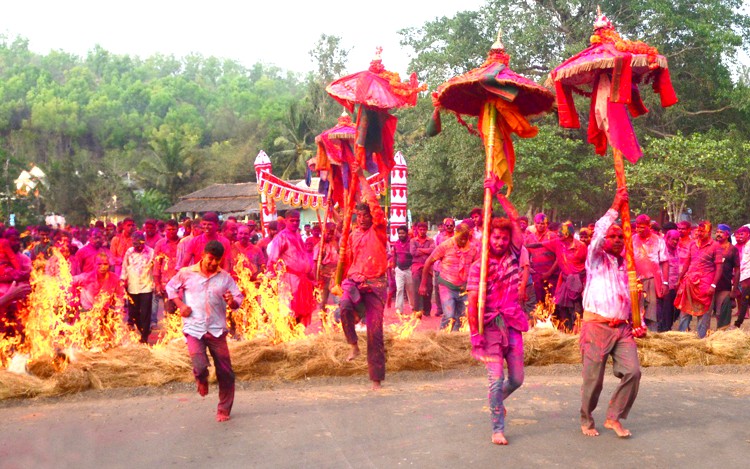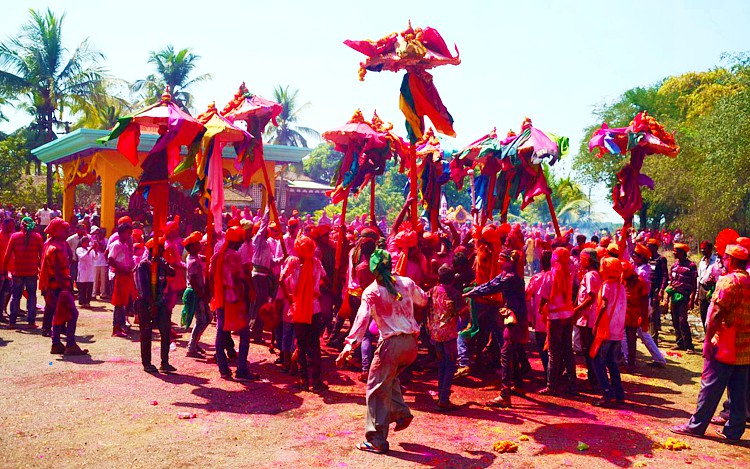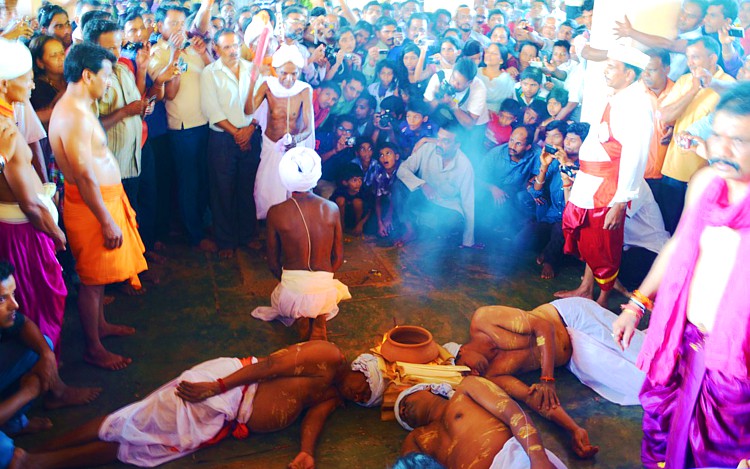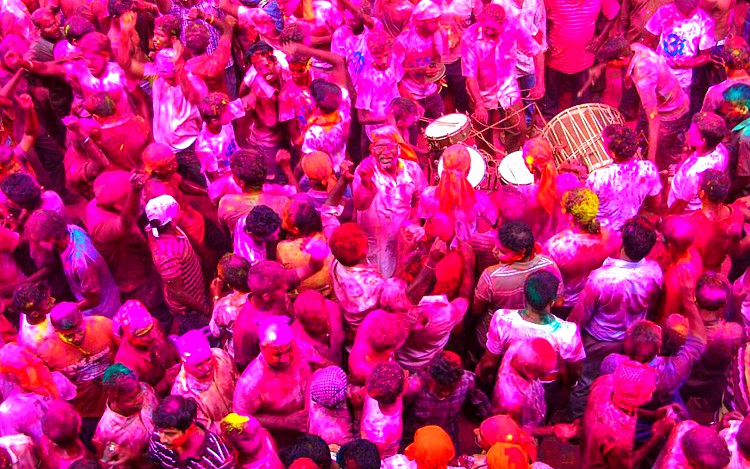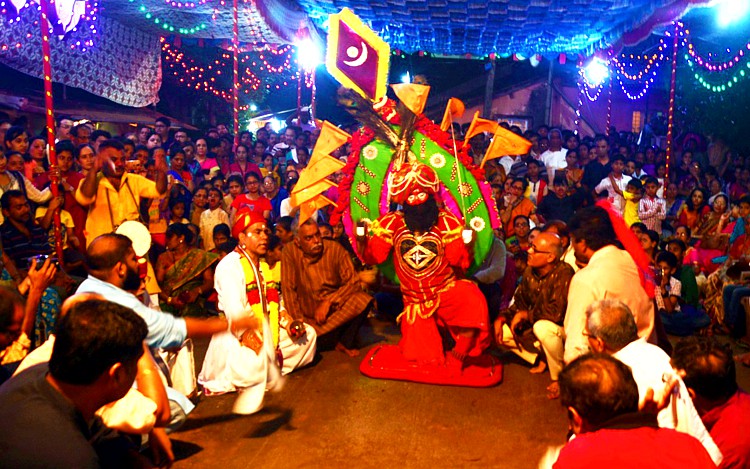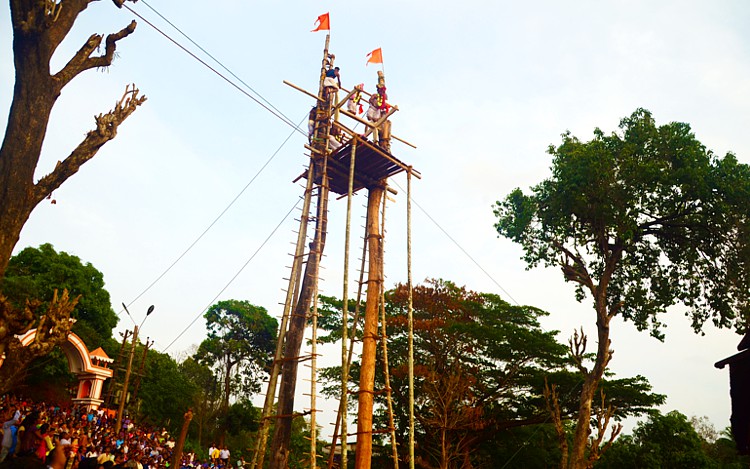Sheni Uzo at Molcornem On the first full moon night after Shigmo, the remote village of Molcornem in Quepem hosts a unique and ancestral village ritual to celebrate the festival, their founding fathers, and their beliefs. In a fast-changing world defined by the use of modern technology, one may be left bewildered as […]
Topshyo: A fiery finale to Shigmo in Fatorpa
Topshyo: A fiery finale to Shigmo in Fatorpa Several temples across Goa observe their own sets of rituals and festivities during Holi and Shigmo, and the celebration at the Shri Shantadurga Fatarpekarin temple at Fatorpa is a sight to behold! On Monday, March 21, 2022, the village and its residents were covered in […]
“Sotreo” Umbrella Festival in Cuncolim
“Sotreo” Umbrella Festival in Cuncolim The traditional “sotreo” umbrella festival is celebrated in Cuncolim with great pomp and gaiety. Thousands of devotees from far and wide pour into Cuncolim to seek blessings of Shree Shantadurga Kunkalikarin as the annual procession wend its way from Fatorpa Temple. The colourful procession carrying the palki of […]
Shisharanni at Gaodongrim
Shisharanni at Gaodongrim ‘Shisharanni’ is a traditional ritual that takes place every third year at the time of traditional Shigmo festival at the Mallikarjun Temple in Gaodongrim, Canacona.. The word Shisharanni derives its name from two words – ‘shisha’ which is a kind of tree and ‘ranni’ which represent a traditional cooking place. […]
Lairai Zatra in Shirgao
Lairai Zatra in Shirgao One of the most looked forward event in the Hindu Calendar of religious festivities is the fire walking held at Shirgao, near Assanora in the Bicholim Taluka. This festival is in celebration of the deity Sri Lairaie. Though Sateri is the presiding deity of Shirgao, goddess Lairai gained popularity […]
Gulal at Zambaulim
Gulal at Zambaulim Gulal is a festival connected with the Shigmo festival of Goa. It is celebrated in the month of Phalgun at the Shri Damodar Temple of Zambaulim. There are no exact records as to when the festival began. During the Portuguese regime, Christianity was introduced, sometimes by force. Hindus and Muslims were suppressed […]
Virbhadra folk dance reflects martial arts tradition
Virbhadra folk dance reflects martial arts tradition Virbhadra at Sanguem Virbhadra at Shiroda Virbhadra at Borim Virbhadra at Ponda Goa is a land where Lord Shiva is worshipped in varied forms. Virbhadra is one of the attendants of Lord Shiva who is regarded in Goa as one of the sons […]
Mussoll Dance at Cota, Chandor
Mussoll Dance at Cota, Chandor At the historical village of Chandor in the Kshatriya (warrior) caste villager’s courtyard this Mussal (pounding mace) march – cum- dance is performed on the second day of Goan Carnival. The dance performed by men who carry ‘Mussal’ – a war weapon in medieval times, is performed with […]
Adpai comes alive as ‘Kutumba Ganeshas’ are immersed
Adpai comes alive as ‘Kutumba Ganeshas’ are immersed The environs of Adpai a tiny village in Ponda taluka comes alive annually on the fifth day of the ‘Chovoth’ as over a thousand families members scattered across Goa, come together for the immersion ritual of the 17 ‘kutumba (family) Ganesh’ idols. The village narrow […]
Gadyaanchi Jatra of Poinguinim
Gadyaanchi Jatra of Poinguinim The festival of Gadyaanchi Jatra, which happens once in three years at Poinguinim, a village in Canacona is celebrated in the name of Shri Betal who is the most feared and highly revered deity of Poinguinim and its neighbourhood. The first year (of the third year) a ritual called ‘Jevnni’ is […]


